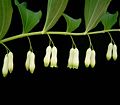Polygonatum
Polygonatum
Polygonatum is a genus of flowering plants in the family Asparagaceae, native to temperate regions of the Northern Hemisphere. These plants are commonly known as Solomon's seal due to the shape of their rhizomes resembling a seal impression. The genus Polygonatum includes around 50 species of herbaceous perennials that are valued for their ornamental qualities and medicinal properties.
Description: Polygonatum plants typically have arching stems with alternate leaves and pendulous, bell-shaped flowers that hang beneath the stems. The flowers are usually white or greenish-white in color and have a sweet fragrance. The plants produce berries that are often red or black when ripe.
Habitat and Distribution: Polygonatum species are found in diverse habitats, including woodlands, meadows, and mountain slopes. They are distributed across Europe, Asia, and North America, with some species being endemic to specific regions.
Cultivation and Uses: Polygonatum plants are popular in gardens for their elegant appearance and ability to thrive in shady areas. They are often grown for their attractive foliage and delicate flowers, which add a touch of beauty to woodland gardens and shaded borders. Some species, such as Polygonatum odoratum, are also used in traditional medicine for their purported health benefits.
Medicinal Properties: Polygonatum plants have a long history of medicinal use in various cultures. The rhizomes and roots of some species contain bioactive compounds that are believed to have anti-inflammatory, antioxidant, and immune-boosting properties. In traditional Chinese medicine, Polygonatum is known as Huang Jing and is used to tonify the spleen and nourish the yin.
Potential Health Benefits: Studies have shown that extracts from Polygonatum plants may have potential health benefits, such as improving cognitive function, reducing inflammation, and supporting immune health. However, more research is needed to fully understand the therapeutic effects of these plants.
Conservation Status: Some species of Polygonatum are at risk due to habitat loss, overharvesting, and climate change. Conservation efforts are underway to protect these plants and their natural habitats.
In conclusion, Polygonatum is a diverse genus of plants with ornamental and medicinal value. From their graceful appearance in gardens to their potential health benefits, these plants continue to captivate and inspire people around the world.
Polygonatum[edit]
-
Polygonatum multiflorum
-
Polygonatum humile
-
Polygonatum odoratum
-
Polygonatum verticillatum
Ad. Transform your life with W8MD's Budget GLP-1 injections from $75


W8MD offers a medical weight loss program to lose weight in Philadelphia. Our physician-supervised medical weight loss provides:
- Weight loss injections in NYC (generic and brand names):
- Zepbound / Mounjaro, Wegovy / Ozempic, Saxenda
- Most insurances accepted or discounted self-pay rates. We will obtain insurance prior authorizations if needed.
- Generic GLP1 weight loss injections from $75 for the starting dose.
- Also offer prescription weight loss medications including Phentermine, Qsymia, Diethylpropion, Contrave etc.
NYC weight loss doctor appointmentsNYC weight loss doctor appointments
Start your NYC weight loss journey today at our NYC medical weight loss and Philadelphia medical weight loss clinics.
- Call 718-946-5500 to lose weight in NYC or for medical weight loss in Philadelphia 215-676-2334.
- Tags:NYC medical weight loss, Philadelphia lose weight Zepbound NYC, Budget GLP1 weight loss injections, Wegovy Philadelphia, Wegovy NYC, Philadelphia medical weight loss, Brookly weight loss and Wegovy NYC
|
WikiMD's Wellness Encyclopedia |
| Let Food Be Thy Medicine Medicine Thy Food - Hippocrates |
Medical Disclaimer: WikiMD is not a substitute for professional medical advice. The information on WikiMD is provided as an information resource only, may be incorrect, outdated or misleading, and is not to be used or relied on for any diagnostic or treatment purposes. Please consult your health care provider before making any healthcare decisions or for guidance about a specific medical condition. WikiMD expressly disclaims responsibility, and shall have no liability, for any damages, loss, injury, or liability whatsoever suffered as a result of your reliance on the information contained in this site. By visiting this site you agree to the foregoing terms and conditions, which may from time to time be changed or supplemented by WikiMD. If you do not agree to the foregoing terms and conditions, you should not enter or use this site. See full disclaimer.
Credits:Most images are courtesy of Wikimedia commons, and templates, categories Wikipedia, licensed under CC BY SA or similar.
Translate this page: - East Asian
中文,
日本,
한국어,
South Asian
हिन्दी,
தமிழ்,
తెలుగు,
Urdu,
ಕನ್ನಡ,
Southeast Asian
Indonesian,
Vietnamese,
Thai,
မြန်မာဘာသာ,
বাংলা
European
español,
Deutsch,
français,
Greek,
português do Brasil,
polski,
română,
русский,
Nederlands,
norsk,
svenska,
suomi,
Italian
Middle Eastern & African
عربى,
Turkish,
Persian,
Hebrew,
Afrikaans,
isiZulu,
Kiswahili,
Other
Bulgarian,
Hungarian,
Czech,
Swedish,
മലയാളം,
मराठी,
ਪੰਜਾਬੀ,
ગુજરાતી,
Portuguese,
Ukrainian




